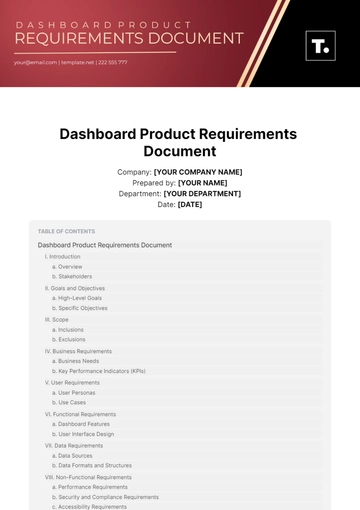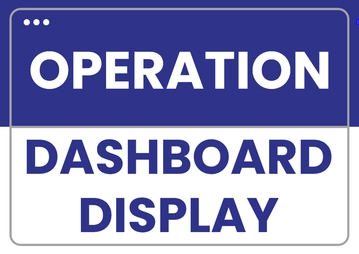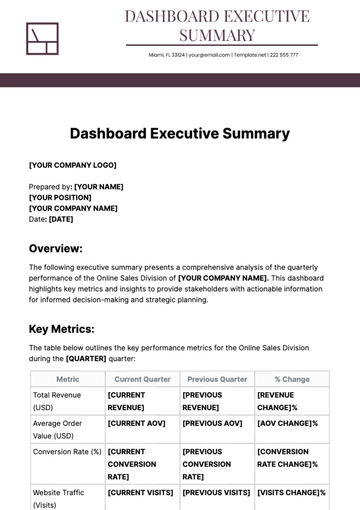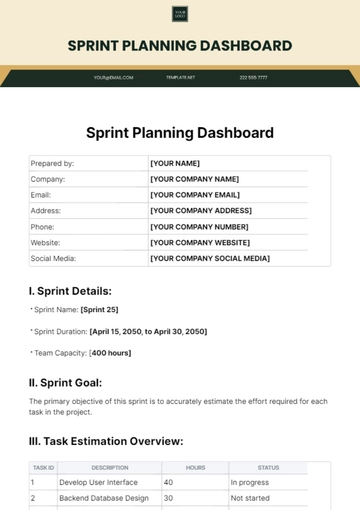Free Dashboard Product Requirements Document
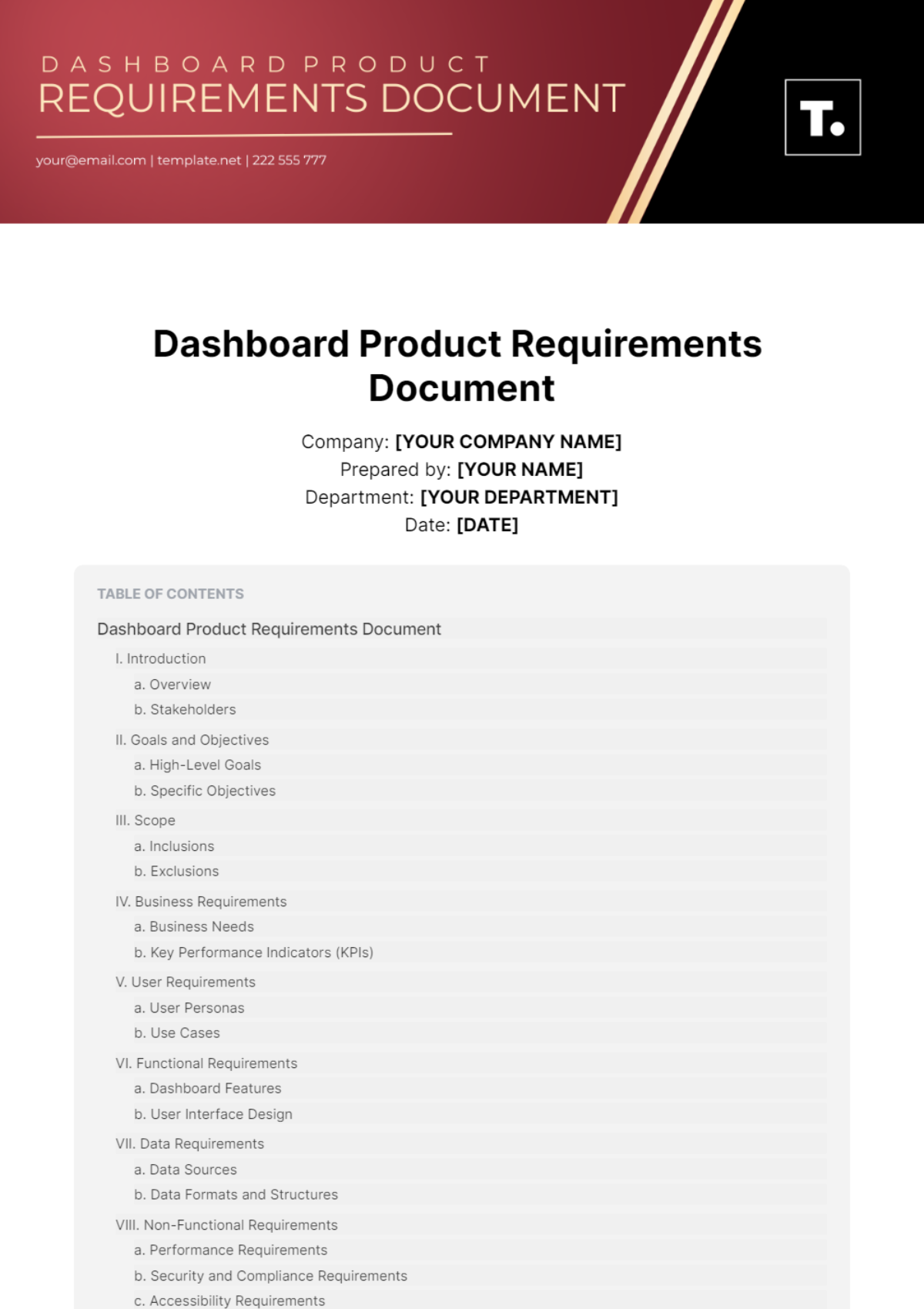
Company: [YOUR COMPANY NAME]
Prepared by: [YOUR NAME]
Department: [YOUR DEPARTMENT]
Date: [DATE]
I. Introduction
a. Overview
The dashboard project aims to develop a data visualization tool that will enable stakeholders to track key performance indicators (KPIs) and make informed decisions based on real-time data.
b. Stakeholders
The primary stakeholders for this project include the product manager, the development team, business analysts, and key decision-makers in the organization.
II. Goals and Objectives
a. High-Level Goals
The primary goal of the dashboard project is to provide stakeholders with a user-friendly interface to access and visualize key business metrics, leading to improved decision-making and performance monitoring.
b. Specific Objectives
To increase data transparency and accessibility across the organization.
To improve data-driven decision-making processes.
To enhance collaboration and communication among stakeholders.
III. Scope
a. Inclusions
Dashboard features such as customizable widgets, drill-down capabilities, and real-time data updates.
Integration with data sources including CRM systems, ERP systems, and external APIs.
Support for multiple user roles and permissions.
b. Exclusions
Advanced analytics features such as predictive analytics and machine learning algorithms.
Integration with legacy systems that are not compatible with modern APIs.
IV. Business Requirements
a. Business Needs
The dashboard project addresses the need for a centralized platform to monitor and analyze key business metrics, aligning with the organization's strategic goals.
b. Key Performance Indicators (KPIs)
Revenue growth
Customer acquisition cost
Customer retention rate
Sales pipeline velocity
V. User Requirements
a. User Personas
Executive management: Requires high-level overview and strategic insights.
Sales team: Needs real-time sales performance data.
Marketing team: Requires campaign performance metrics.
b. Use Cases
An executive dashboard displaying KPIs at a glance.
A sales dashboard with detailed pipeline and revenue metrics.
A marketing dashboard showing campaign ROI and engagement metrics.
VI. Functional Requirements
a. Dashboard Features
Customizable widgets: Users can add, remove, and rearrange widgets on the dashboard.
Drill-down capabilities: Users can click on data points to view detailed information.
Real-time data updates: Data is refreshed automatically at regular intervals.
b. User Interface Design
Clean and intuitive interface.
Responsive design for use on desktop and mobile devices.
Support for custom themes and branding options.
VII. Data Requirements
a. Data Sources
Salesforce CRM for sales data.
Google Analytics for website traffic data.
Internal database for product performance data.
b. Data Formats and Structures
Data should be in JSON or CSV format for easy integration.
Structured data with clear naming conventions for consistency.
VIII. Non-Functional Requirements
a. Performance Requirements
Dashboard should load within 3 seconds.
Support for 1000+ concurrent users.
b. Security and Compliance Requirements
Data encryption in transit and at rest.
Compliance with GDPR and other relevant regulations.
c. Accessibility Requirements
Support for screen readers and keyboard navigation.
Color contrast ratio compliant with WCAG standards.
IX. Constraints
a. Budget Constraints
The total project budget is $100,000.
No additional budget for hardware upgrades.
b. Time Constraints
The project deadline is 6 months from project initiation.
c. Technological Constraints
Use of existing technology stack (Java, React, MySQL).
X. Assumptions and Dependencies
a. Assumptions
Stakeholders will provide timely feedback during the development process.
Data sources will be available and accessible for integration.
b. Dependencies
Integration with Salesforce API for CRM data.
Collaboration with the IT department for database access.
XI. Risks and Mitigation Strategies
a. Potential Risks
Data integration issues delaying project timeline.
User adoption challenges due to lack of training.
b. Mitigation Strategies
Conduct thorough testing of data integration before launch.
Provide training sessions for users prior to dashboard rollout.
XII. Approval
To move forward with the development of the proposed dashboard, approvals are required from the following roles:
Role | Name | Signature |
|---|---|---|
Project Manager | [YOUR NAME] | [YOUR SIGNATURE] |
Technical Lead | [TECHNICAL LEAD'S NAME] | [SIGNATURE] |
Client | [CLIENT'S NAME] | [SIGNATURE] |
XIII. Version Control
Version | Date | Description |
|---|---|---|
Version 1.0 | [DATE] | Initial draft. |
Version 1.1 | [DATE] | Revisions post stakeholder feedback. |
Version 1.2 | [DATE] | Final approval. |
- 100% Customizable, free editor
- Access 1 Million+ Templates, photo’s & graphics
- Download or share as a template
- Click and replace photos, graphics, text, backgrounds
- Resize, crop, AI write & more
- Access advanced editor
Revolutionize your project management with the Dashboard Product Requirements Document Template from Template.net. This customizable template is meticulously crafted for efficiency and precision. Easily editable in our Ai Editor Tool, it allows you to customize every detail to align with your project's unique requirements, ensuring seamless development processes and enhanced project outcomes.
